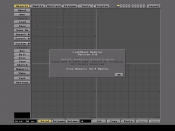In 1988 Newtek were looking for a 3D application to include with their new VideoToaster video processing hardware for the Amiga. What eventually became Lightwave started life as two different programs for the Amiga, called Videoscape 3D and Aegis Modeler 3D. Videoscape was written by Allen Hastings and Modeler 3D by Stuart Ferguson. The merging of these two programs explains why Lightware has two distinct parts to it, the modeler and the scene animator.
The Lightwave 3D application started out as part of the software included with the Newtek Videotoaster hardware; a powerful video editing and post production Zorro based hardware solution. It utilised the processing power of the Videotoaster hardware to manipulate the 3D objects during construction, and with the final raytrace rendering. Most of the functions within Lightwave are multi-threaded, meaning it can utilise multiple processors to perform complex calculations. In the case of the initial versions this meant being able to utilise the Amiga's own CPU, along with the processing of the Newtek VIdeotoaster hardware. Lightwave was also one of the first 3D packages to feature a built-in radiosity render engine.
As the Newktek Videotoaster hardware was developed and improved, so was Lightware. The first version was released in 1990, and the next version 2 was released in 1992 alongside a new upgraded Videotoaster hardware release. A year later in 1993 version 3 was released. At this point a small company called Might and Logic developed a hardware dongle called LightRAVE, which allowed people to run Lightwave without the Video Toaster hardware. The LightRAVE dongle basically tricked the software into thinking the VideoToaster hardware was present. This was to cater for all of the users who wished to use the software, but couldn't use the VideoToaster hardware for various reasons such as not being in a country that used the NTSC TV system.
Due to this Lightwave's next version, version 3.5, was a proper standalone version, released in 1994.
A year later version 4 was released, and this was also the first version to be ported to the Windows and DEC Alpha platforms.
Later the same year in 1995 version 5 was released. This was to be the final version on the Amiga. This version was also released for SGI, DEC Alpha, and the Macintosh.
Since version 5 development has continued on the PC and Mac, and is still going strong, current up to version 9.3 on the PC, and Lightware is used extensively by 3D professionals in Film, TV and music videos.
The Amiga versions of Lightware were famously used to create the special effects in many well known TV series and Films. These include Babylon 5, Seaquest, Star Trek Deep Space Nine, Star Trek IV The Voyage Home, NASA, Max Headroom, Jurassic Park and Terminator 2... and many more.
You can read much more about the history of Lightware by visiting the Lightwave History Wiki, found at http://www.lightwiki.com/






















